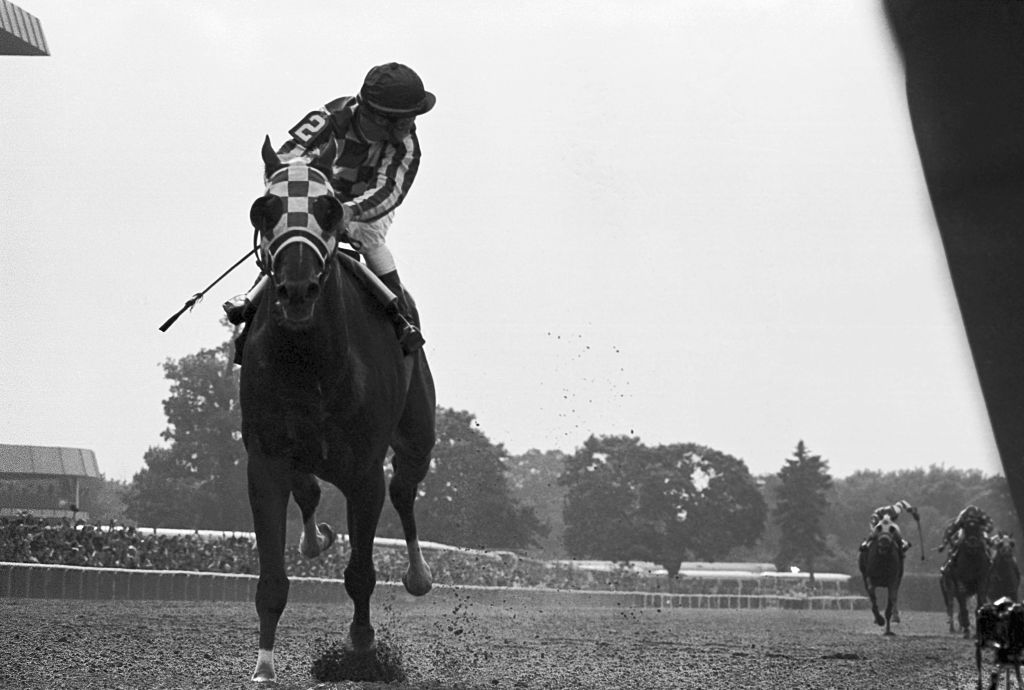Fifty years ago next weekend, I saw the greatest athletic feat of my lifetime: Secretariat’s record-setting—rather, record-shattering—31-length victory at the Belmont Stakes. With the win, “Big Red,” or just “Red,” as the thoroughbred was known to his owner, trainer, and jockey, swept to the Triple Crown, winning each leg (the Kentucky Derby, the Preakness, and finally, the Belmont Stakes) with times that remain track records. If records are made to be broken, reflecting the fleeting nature of time and excellence, then Secretariat comes as close to immortality as any earthly being I have known.
Secretariat was as stunning a horse as he was fast. Having a coat of bright chestnut with three white stockings, he stood over 16 hands and, as one of his team described him, “was the biggest, strongest, most attractive and powerful animal you could ever lay your eyes on. He was a heartthrob.” And inside that powerful body was, a post-mortem necropsy revealed, an engine—a heart that weighed nearly three times that of the typical thoroughbred.
Every year about this time, I watch the movie Secretariat. It’s a passable flick, not as good as Seabiscuit as equine-themed movies go. I say “passable” because much of the movie’s focus is on Secretariat’s owner, Penny Chenery, and her personal and financial struggles to keep her father’s horse breeding and racing operation solvent.
But the races themselves should have been the storyline—a fact brought home by the movie’s end with the actual footage of Secretariat’s overwhelming victory at the Belmont. Grown men (including yours truly) have been known to weep at the sight of that ungodly handsome and powerful animal’s margin of victory that long-time track professionals didn’t think was possible—and even now wonder how it was. It was enough to make you forget for a moment that this was the summer of the Watergate hearings.
Secretariat’s success as a 3-year old in the Triple Crown was no surprise. He’d already been voted Horse of the Year in 1972 as a 2-year old—the first ever to claim the honor at that age. Even so, in winning the three Triple Crown races, he seemed to show just a bit more of his greatness each time, teasing the American public with what might come next.
At the Derby, Secretariat, starting on the outside of a 13-horse field, was dead last as the horses crossed in front of the stands for the first time. Past the first turn and headed into the backstretch, Secretariat’s jockey, Ron Turcotte, moved him to the outside. Secretariat gradually picked off one horse after another. At the far turn, Secretariat had moved into fifth position and, by the turn to the homestretch, he had caught his only serious challenger, Sham. Running stride for stride temporarily, almost teasing Sham to try to stay with him, Secretariat then pulled away. He won by a comfortable margin of two-and-a-half lengths. Secretariat had run the race like an 18-wheel semi: building and building momentum as he ran the course, steamrolling to Derby victory.
Only six horses ran in the Preakness. Most owners knew it was fool’s gold to think their horse had much of a chance against either Secretariat or Sham. As before, Secretariat was last in passing the grandstand. But this time, instead of gradually grinding down the opposition, by the first turn, Turcotte had Secretariat running in high gear, taking it like a Ferrari at Le Mans. By the next turn onto the backstretch, it was full pedal-to-the-metal, with Secretariat blowing past the other thoroughbreds in the straightaway. By the turn into the homestretch, Secretariat had two lengths on Sham and literally put his hindquarters into cruise control, winning by nearly three lengths.
Even as great as Secretariat had been at Churchill Downs and Pimlico, a victory at the Belmont was no sure thing. The race has been the downfall of many aspirants to the Triple Crown. The Kentucky Derby extends 1¼ miles, and the Preakness is a hair shorter, 1 3/16. But the Belmont is 1½ miles, and the extra distance has proved too much many times: Nearly two dozen horses have won the first two legs of the Triple Crown only to come up short at the Belmont.
But Secretariat at the Belmont was a different matter altogether. According to various accounts, the morning of the race, Secretariat was wound so tightly that his handlers thought his muscles might just rip through his coat. Led out of the stable, he reeled up on his hind legs and pawed at the sky like some modern-day Pegasus, wanting to do the impossible. And the seemingly impossible he did.
There would be no running in last place to start the race that day. By the turn into the back stretch, Secretariat and Sham were already eight lengths clear of the rest of the field, then 10 lengths by mid-stretch. At that point, it was “good-bye Sham,” with Secretariat having a good six- to seven-length lead into the far turn. Unlike the Preakness, there would be no cruising to a win. Driving into history with his piston-like, quick recoil, ground-eating stride, Secretariat moved further and further ahead: 12, then 15, then 18, then 24, then 30 and, finally, an unbelievable 31 lengths ahead of Sham as he crossed the finish line.
I watched the Belmont not in my apartment, at a friend’s place, or a bar. I watched the race in a hospital with my mother, who would pass away just four days later. Secretariat could not escape the inevitable either, passing away some 16 years later by lethal injection to remove him from the misery of a debilitating hoof disease. But Secretariat’s ending does not belie his greatness. Because of what he did over the late spring and summer of 1973, and especially with one race at Belmont Park, Secretariat ensured he would never be forgotten.






Please note that we at The Dispatch hold ourselves, our work, and our commenters to a higher standard than other places on the internet. We welcome comments that foster genuine debate or discussion—including comments critical of us or our work—but responses that include ad hominem attacks on fellow Dispatch members or are intended to stoke fear and anger may be moderated.
With your membership, you only have the ability to comment on The Morning Dispatch articles. Consider upgrading to join the conversation everywhere.